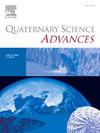1984年至2023年间,由于气候变化导致的秘鲁白卡山脉冰川恢复力的丧失
IF 2.2
Q2 GEOGRAPHY, PHYSICAL
引用次数: 0
摘要
近几十年来,由于全球变暖,高山冰川的消失速度加快,仅秘鲁就在50年内造成了一半以上冰川面积的消失。科迪勒拉·布兰卡是世界上海拔最高、冰川覆盖最广的热带山脉,冰川提供的溪流为下游数十万人提供了水。以前的清查和冰川特定质量平衡研究记录了持续和持续的质量损失。然而,冰川的大范围恢复力——每年积累降雪以抵消面积损失的能力——仍然是一个无法量化的变量,这对于了解冰川随时间的演变和气候响应以及更好地预测未来几十年的质量变化非常重要。因此,我们分析了1984 - 2023年整个冰川覆盖的白科勒拉冰川年净冰川面积与积雪波动和气候变率的关系。为此,我们使用多光谱Landsat图像通过计算归一化水差指数来识别清洁冰川和区分堆积区域。结果显示,冰川面积减少了44%,从2013年前的年平均54,469公顷减少到随后几年的42,700公顷。我们的研究结果表明,冰川已经超过了一个重要的质量平衡阈值,因此自2012年以来,冰川已经失去了恢复质量的能力。我们还记录了冰川面积与全球平均温度增加的强烈负相关,最大的损失发生在最后的强El Niño-Southern涛动(ENSO)阶段。我们得出的结论是,在过去的十年中,冰川的恢复能力已经减弱,科迪勒拉布兰卡的冰川消融主要是由平均温度的升高所驱动的,而退缩最大的冰川是那些其周长按比例更多地暴露于其他类型表面(即基岩或湖泊)的冰川。本文章由计算机程序翻译,如有差异,请以英文原文为准。

The loss of glacier resilience due to climate change throughout the Cordillera Blanca, Peru between 1984 and 2023
The loss of mountain glaciers has accelerated in recent decades, linked to global warming, which in Peru alone has caused the loss of more than half of its glaciated area in fifty years. The Cordillera Blanca is the highest and most extensively glacierized tropical mountain range in the world, and glacier-fed streams provide water for hundreds of thousands of people living downstream. Previous inventories and glacier-specific mass balance studies have documented persistent and sustained mass loss. Yet the range-wide resilience of glaciers – the capacity to accumulate annual snowfall to offset area loss – remains an unquantified variable that is important to understand the evolution and climate response of glaciers over time and better project future mass changes for the coming decades. Therefore, we analyze the relationship between the annually clean glacier area and snow cover fluctuations and climate variability throughout the entire glacierized Cordillera Blanca between 1984 and 2023. To this end, we used multispectral Landsat imagery to identify clean glaciers and distinguish accumulation areas by calculating the Normalized Water Differential Index. The results show a 44 % reduction in glacier area, reflected in a decrease from the pre-2013 annual average of 54,469 ha to 42,700 ha in subsequent years. Our results suggest glaciers have passed a significant mass balance threshold, such that since 2012, glaciers have lost their ability to regain mass. We also document a strong inverse correlation of glacier area with the increase in global mean temperature, with the greatest loss occurring during the lasts strong El Niño-Southern Oscillation (ENSO) phases. We conclude that glaciers have become less resilient over the past decade, that the deglaciation of the Cordillera Blanca is primarily driven by increasing average temperatures and that the glaciers with the greatest retreat are those with perimeters proportionally more exposed to other types of surfaces (i.e., bedrock or lakes),.
求助全文
通过发布文献求助,成功后即可免费获取论文全文。
去求助
来源期刊

Quaternary Science Advances
Earth and Planetary Sciences-Earth-Surface Processes
CiteScore
4.00
自引率
13.30%
发文量
16
审稿时长
61 days
 求助内容:
求助内容: 应助结果提醒方式:
应助结果提醒方式:


